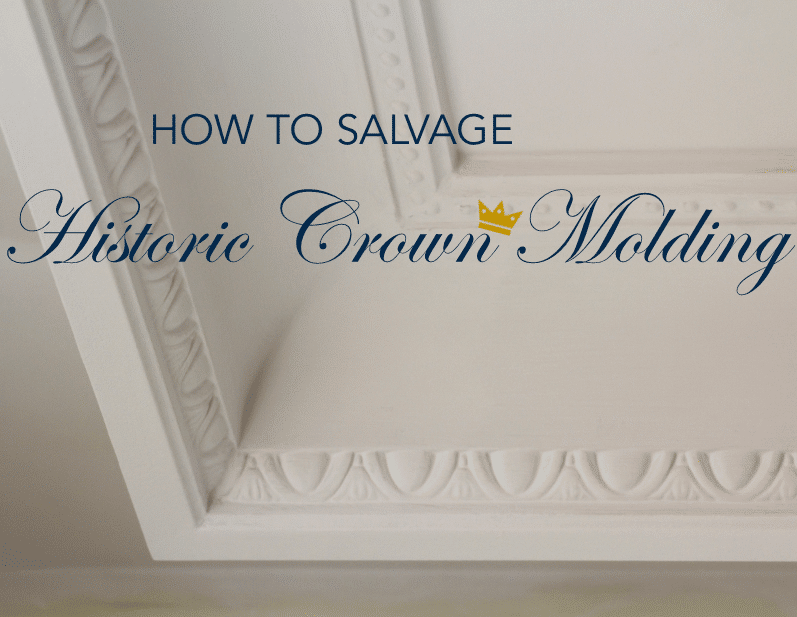Whether you’re doing a rehab or restoration, preserving the period charm of a DC row house should be a top priority because it can save you money in material expenses and increase your property’s ARV. Antique millwork is usually made of hardwoods like heart of pine or maple, giving you an instant upgrade over box-store stock trim.
A thorough inspection of your property is very important in detecting damage from infestations. Antique millwork can be extremely valuable, however, DC’s humid climate can expose your property’s trim to termites and carpenter ants, jeopardizing any reuse. What’s the best way to identify damage and how do you know if the trim is original and adds enough value to warrant the salvaging/restoration costs?
That’s where this guide comes in. Read below to learn everything from damage detection to how to evaluate if it’s worth restoring, replacing select areas, or starting from scratch with all new trim.
How to Research Historic Trim and Molding Styles in Washington D.C.
By knowing the difference between modern trim and historic molding before visiting touring an investment property, you’ll be able to better identify these historic elements and how they can impact your renovation budget and resale value. Here are a few ways you can research what historic woodwork looks like in Washington, D.C. to help you identify historic trim.
- Visit open houses in historic neighborhoods near your investment property. If you can’t go in person, look at the listing photos and pay close attention to crown molding, baseboards, and decorative trim in areas like staircases and fireplaces. Look for listings built in the same decade as your flip house and those that use the term “original moldings” and “period charm” in the description.
- Browse catalogs from suppliers of architectural salvage or reproduction moldings. See what details are typical for the time period when your investment property was built. Kuiken Brothers have an excellent illustrated Molding & Millwork Design Catalog with sections devoted to historically accurate moldings vetted by experts.
- Check with your local historic organization, which in DC is the Historic Preservation Office. You can also check if your property or other houses on your street have been in the National Register of Historic Places.
Ways to Identify Common Historic Moldings by Type and Era
Once you’ve learned how to recognize historical millwork, you’ll be able to use your trained eye to quickly evaluate a property’s woodwork. As you walk through, gauge the potential savings by salvaging it before you make an offer. This will help you figure out roughly how much you can expect to pay to incorporate high-end trim work in the property, giving you an edge in a hot seller’s market.
The first step to identifying original period molding is knowing what era and style it belongs to. You’ll want to look for molding that was made around the same time as the home was built. You can’t always rely on a real estate listing to identify your home’s building style because MLS listings aren’t reviewed for accuracy by any sort of architectural editor, so you’ll have to figure out the molding style by looking at the profile and details of the woodwork. Here’s a handy guide to styles common in Washington, DC and northern Virginia area homes built between 1795-1945.
Trim and Molding Style Guide for Historic Properties in the DMV
| Architectural Type and Era | Distinguishing Trim Features | |
|---|---|---|
| Federal/Classic Revival (1795-1835) | Flat baseboards and tall crown molding with simple, plain lines | Dentil horizontal moldings |
| Victorian (1835-1900) | Tall baseboards with lips | Highly detailed and ornate details |
| Colonial Revival (1880-1945) | Bullnose baseboards and casings that are more ornate than the Federal style | Double hung windows with multiple panes with reeded casings |
| Craftsman (1905-1930) | Simple lines that are squared off and geometric without rounded edges | Showcases natural wood features, stained or varnished rather than painted |
Check the Trim for Infestations Before Calculating Salvage Savings
Old wood often harbors insects and other pests. Humid cities like Washington, DC are prone to termites, and carpenter ants that plague the majority of the east coast. Look for signs of carpenter ants along the quarter molding attached to the floor and around window casings. If you see sawdust, tiny holes bored through the wood, or hear rustling sounds in the walls, these are warning signs that you need an exterminator and that your trim might have insect damage where you can’t see it. Termites are more difficult to diagnose, but a qualified home inspector or pest control expert should be able to tell you if there’s an insect problem you’ll need to fix.
Carpenter ants and termites don’t have to be deal breakers, but they will significantly affect your renovation budget because not only will you have to repair or replace the damaged wood, you’ll also have to pay for an exterminator. If you’re doing a fix-and-flip to sell in DC, Virginia, or Maryland, you’ll have to disclose that you treated for termites which can make buyers skittish and could even translate into more days on the market. Salvaging original woodwork to reduce expenses is one way to offset these extra costs.
Check for Molding Authenticity
Authentic historic molding is usually made of quarter sawn hardwood which creates a smooth, straight grain with parallel lines. Stained or varnished molding that showcases the natural beauty of the grain will always be made of wood.
Trim is often painted, however, and that’s where the clever imposter comes in. MDF, or medium density fiberboard, can look just like wood when it’s painted but it’s actually made of wood fibers held together with resin that has been compressed. It’s denser than plywood, but it’s also not as durable as real wood. MDF tends to tear and shred when removing, making it impossible to save and reuse.
The easiest way to tell if the molding in your rehab is real wood or unsalvageable fiberboard is to look for the grain. If it’s painted and you can’t see it, try looking inside a closet for unfinished pieces inside, or you can remove the paint with sandpaper in an inconspicuous spot to check if there’s raw wood underneath or something else.
If you don’t have real wood moldings, don’t despair. Run your numbers again with the additional outlay for new moldings and you might find that your profit margin is still big enough to justify the expense. If the trim is in good condition and you don’t plan extensive renovations requiring its removal, you might be able to refinish the existing moldings with a shiny new coat of paint and have it look just fine without costing anything at all.
Look for Missing and Broken Pieces
Cracked or damaged molding doesn’t have to be a deal breaker. One of the great things about wooden trim is that it can be repaired easily. Small repairs can be sanded out, and pieces that have been glued back together will look great once they’re disguised with a good coat of paint and put back in the room.
Beware if large areas of molding are missing, as you might not be able to repurpose it in your flip. Matching up moldings from a bygone era can be difficult and costly, requiring a special order or the commissioning of custom millwork, which can blow your budget and affect your overall margin. If you have to wait for your custom reproduction trim, it can increase your carrying costs as you wait weeks for delivery. You might be better off ordering reproduction moldings from a catalog that carries ready to go inventory or matching the style of the period with modern stock.
Shiny New Hardware Usually Means New Trim
If you see shiny nickel hardware on the windows or brushed stainless steel locks on the door, it’s possible the trim has been replaced and you should inspect it carefully to see if it’s high-quality hardwood that could be salvaged for savings, or if it’s lower quality trim to be replaced, meaning another line item in your budget.
Older houses usually have vintage hardware, including pieces like sash pulls and stays not found in newer homes. They are made of metal and are often adorned with beautiful floral designs and motifs from nature. Metal develops a beautiful aged patina over time, and older pieces are solid cast, which makes vintage brass or bronze is easy to spot.
Areas that can benefit from the grandeur of historic moldings are usually spaces people use to relax, like the master bedroom or around a fireplace. Luckily, these are areas that are the least likely to have moldings damaged by wear and tear and usually haven’t been renovated as often as kitchens and bathrooms meaning the original woodwork might still be intact. Spending your time restoring a gorgeous Colonial Revival mantle with reeded millwork as the focal point for the living room will help you create stunning listing photos to get your house sold or leased faster.

